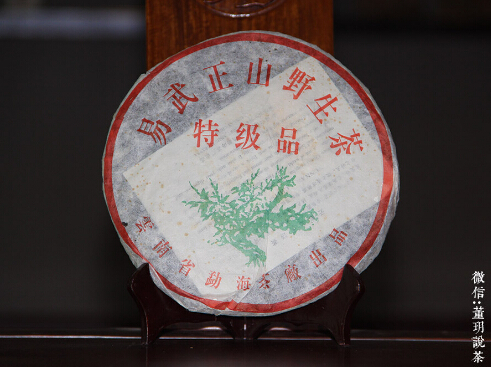
Guide: Previously, I introduced how to taste raw Pu-erh tea and ripe tea. Later, many tea friends suggested on my WeChat (dydy800) that I also talk about how to taste aged Pu-erh tea. This issue continues to introduce how to brew aged tea for the best taste.
A good tea is the foundation, and brewing is the process of giving it a second life. The correct and reasonable brewing method is a respect for the aged tea and the tea drinker, and it is also the guarantee for an aged tea to showcase its charm.
How should aged tea be brewed to experience its exquisite flavor? Taking this Dayi 2003 Yiwu Zhengshan (Green Big Tree) collected by "Nanming Jiaren" as an example, today I will share the method of brewing aged tea. For an introduction to Green Big Tree, add WeChat: dyshuocha to view.
Brewing tea is not just simply adding tea leaves and pouring water, nor is it repeatedly pouring and drinking. Before brewing tea, first, the mind must be calm. Many things can only be understood by doing them carefully and quietly, such as reading books, such as brewing tea.
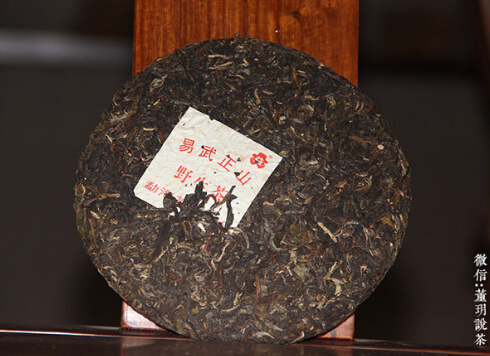
The essence of aged tea is hidden in the taste of time bestowed by the years. "Life is like tea" is not just a casual saying. New tea is often sharp like a youth, while aged tea is peacefully quiet like middle age, shedding complicated outer layers, leaving endless roundness and包容 (tolerance/inclusiveness). Myriad changes are hidden behind the warm tea soup. Without a calm heart, how can one brew out this ordinary yet extraordinary flavor?
Brewed on December 12, 2015, at the Nanming Jiaren Teahouse in Kunming. Weather: overcast, room temperature about 18 degrees Celsius. Brewed using a Zisha teapot, 8 grams of tea leaves.
For aged tea, brewing with a Zisha teapot is a relatively good choice. Good tea deserves a good pot, so they complement each other.
Before brewing, first awaken the pot with boiling water. This serves the same purpose as warming the cup with a gaiwan. Pour boiling water thoroughly inside and outside the Zisha pot. Add tea leaves into the pot. Because the pot is relatively large, 8 grams of tea were added. If the pot is small, the amount of tea should be appropriately reduced. For example, for one or two people drinking, a small pot requires about 4-5 grams of tea.
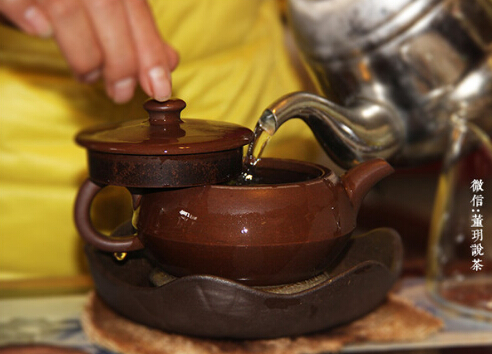
The process of awakening the pot and awakening the tea is very important. If the pot has already been awakened by high-temperature rinsing before adding the tea, during the first rinse, pour boiling water into the公道杯 (fairness cup) first, then into the Zisha pot, slightly lowering the water temperature. If the pot has not been awakened by high temperature, during the first rinse, pour boiling water directly into the pot to awaken both the pot and the tea.
Rinse the tea twice, boiling water in and out immediately. Here is an additional point about water pouring.
For brewing aged tea, the primary requirement is high temperature. The water temperature must be high. Aged tea, after more than ten years of precipitation, has entered a stable transformation state. High temperature is needed to stimulate the hidden internal qualities. Therefore, when brewing, to ensure the water temperature, when pouring boiling water into the pot, pour low and quickly. Except for adding water, do not open the lid to maintain the temperature inside the pot and also to收敛 (收敛 - converge/retain) the tea气 (qi - energy).
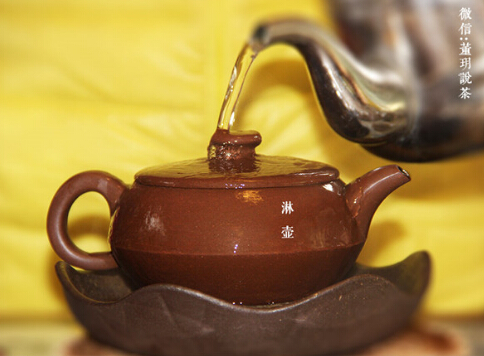
After each infusion of water, rinse the outside of the pot with boiling water once to maintain high temperature. Additionally, when pouring water, let the water overflow the pot mouth slightly, allowing the tea soup to浸润 (moisten) the pot body, which has a good effect on nurturing the pot.
When brewing, for the first six infusions, you can pour in and out immediately. The Green Big Tree has relatively high durability. The taste of the tea soup remains very full throughout. The aged aroma and woody aroma of the aged tea are very strong. This is also the advantage of brewing aged tea with a Zisha pot: the tea气 (qi) and tea aroma are more gathered,能够 (able to) maintain a high and strong aroma. Quick infusion under high temperature can stimulate the flavor while reducing astringency.
After six infusions, start to gradually increase the steeping time with each brew. Do not increase too much each time; increase progressively by 5 seconds — 10 seconds — 15 seconds — 20 seconds, etc., depending on the fullness of the tea soup's taste and whether a watery taste appears. The durability of Green Big Tree can reach about 15 infusions. We started延长 (prolonging) the infusion after the ninth brew. By the fifteenth infusion, steep for 1 minute. The aroma changes from steady and厚重 (heavy) to high and overflowing. The aged aroma gradually hides, while the woody aroma and fungal aroma are extremely rich. The sweetness increases. When drinking, it is comfortable and refreshing, with a fresh warmth. For how to taste tea, follow Dong Yue's WeChat: dyshuocha to view.
After the ninth infusion, when brewing, you can increase the number of times you rinse the outside of the pot to increase the temperature inside the pot, stimulate the tea's internal qualities, and enhance the aroma.
Starting from the twelfth infusion, when pouring out the tea soup each time, do not pour it all out; leave about one-third of the tea soup in the pot, and pour it out together with the next infusion. This is commonly called "leaving a root" (留根). This can also maintain the fullness of the subsequent tea soup taste and increase the durability of the aged tea.
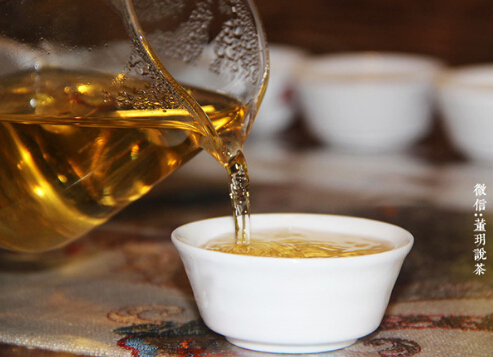
The 2003 Dayi Green Big Tree, when drunk, has a full and mellow taste in the first half, with a strong throat-moistening feeling,持久 (long-lasting) sweet aftertaste, mellow and sweet, deep韵味 (yunwei - charm/aftertaste). It's like having a pile of sugar stuck in the throat; you can feel the sweet aroma overflowing when breathing. The aftertaste is pure, sweet, and soft. The水路 (shuilu - water path, texture in mouth) is delicate, the texture is fine and soft; the aged aroma is steady and厚重 (heavy). In the second half, the woody aroma appears, and the fungal aroma carries a freshness of primitive forest, becoming ethereal and elegant, high and张扬 (flamboyant).细细 (Carefully)回味 (recall the taste), there is a kind of "long time no see" old, nostalgic atmosphere, like meeting an old friend again after a long separation, suddenly encountering a familiar face on the street corner,带来 (bringing) surprise and nostalgia.
Brewing aged tea, although it doesn't require bathing and changing clothes, still emphasizes peace and calmness. Weather, mood, or environment will affect the performance of the tea's taste and flavor. When brewing, maintain a calm mind, adjust the brewing method appropriately according to the characteristics of the tea. Good tea also very much needs good brewing skills to better展现 (display) the characteristics of the tea and taste its true flavor.
Aged tea is very rare. Its connotation and characteristics are only bestowed by time and cannot be changed artificially. The taste of the years contained within is the preciousness of aged tea. When tasting aged tea, you must have patience.切勿 (Do not) negate a tea completely because the first sip doesn't taste good. Infinite风光 (scenery) is在险峰 (at dangerous peaks). Good flavor is often hidden in the next infusion.
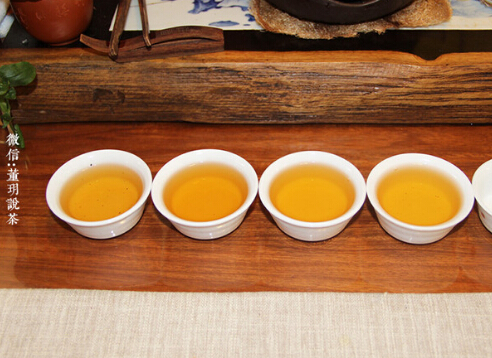
"Only with the heart can one see rightly; what is essential is invisible to the eye." — "The Little Prince"
Tasting tea is the same. Taste with heart, seriously discover the advantages of a tea, like it from the heart,才能 (then you can) see the true charm and characteristics of the tea.
If you are interested in Pu-erh tea or have questions, you can add my personal WeChat: dydy800, and I will try my best to answer for you.
Text/Dong Yue (Founder of Nanming Jiaren, Senior Tea Artist, Tea Taster) Dong Yue's tea series articles are now simultaneously updated on well-known websites such as Sohu.com, Shuocha.com, China Tea Net, and Banxia Tea Network.